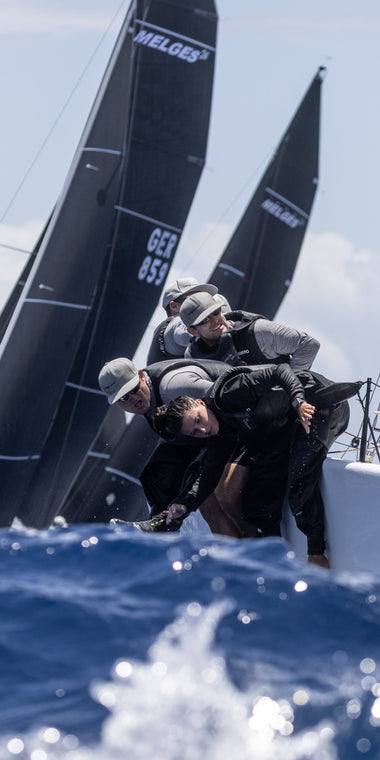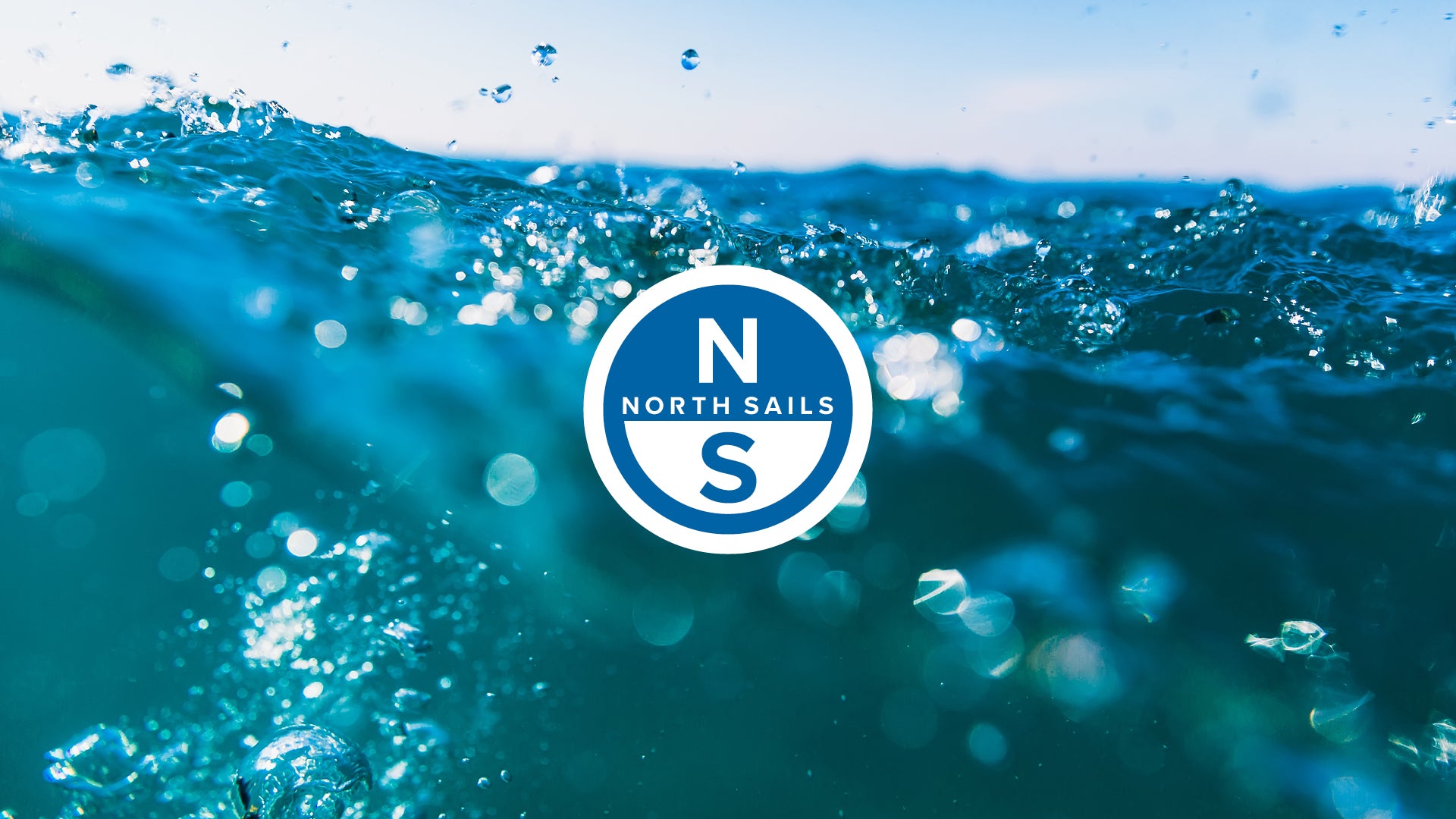MELGES 20 SPEED GUIDE
Class leader Brian Janney answers your speed and boat handling questions.
Who sails a Melges 20?
The boats are just plain fun to sail. They are keelboats, but you sail them more like a dinghy. Naturally, people come out of dinghy classes but also down from bigger boats, attracted by the acceleration a boat like the Melges 20 delivers. The boats have a wet, fast downwind ride that really gets going in 12 knots of breeze with a “lazy plane” mode. The boats are also physical, so the three-person teams need to be in good shape. Some teams with a small person on the helm will sail with four—there’s no weight limit.
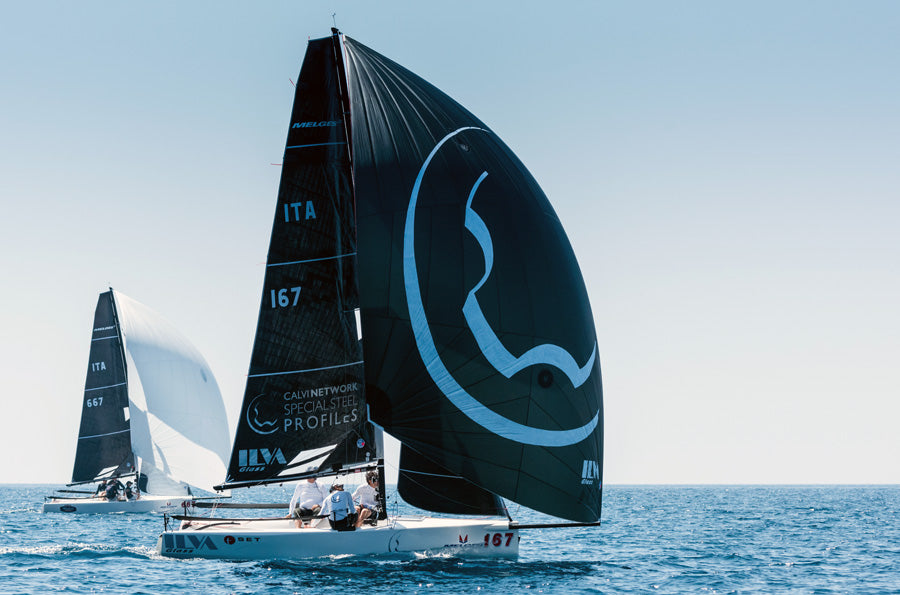
Downwind in lighter air, the crew sits forward and close together. While soaking low is a goal, boats in a fleet typically match angles and speed.
Owner/drivers must be amateurs, but the
Melges 20 Class Association
puts no restrictions on professionals as crew. That was an advantage when the class got started in 2009, but the gap between teams with pros and the rest is narrowing, and Corinthian teams are now winning races, too. We usually have a debrief after racing, pulling some top people from the crowd to do a Q&A. People also get together for dinner. What you can count on, if there’s been any wind, is that everyone hangs out on the dock together, and everybody is smiling.
What kind of sailors do best in this class?
Sailors need to be in good shape. You sail with legs inboard and no hiking is allowed, but that means you lean back against the padded lifeline and need to support your body while you’re constantly playing the controls. Core strength is at a premium.
What are the top 3 things needed to compete successfully in the Melges 20?
Crew practice allows you to make big gains on downwind boathandling.
The class uses sail buttons: invest in new sails and pull them out when it counts.
Be sure the jib furler and shroud cars are in good operating condition.
Who does what on the boat?
The owner/helmsperson drives upwind and down. Because the boats have no backstay or traveler, the middle crew always plays mainsheet. The forward person trims the jib sheet, plays the vang, and adjusts the shrouds, which are on track-mounted cars.
What is the ideal crew size?
With no crew-weight limit, teams are anywhere from 550 to 620 pounds—sometimes more. Typically, most sailors are male. When women or teenagers sail, it’s common to carry four in the crew.
How physical is the crew work?
The forward position is the most physical—you play all the controls while hiking and giving feedback on the racecourse. The middle crew vang-sheets the square-top main. The keel isn’t very heavy, so the mainsail has to be played like a Laser or 420 or you’ll heel over—it never gets cleated going upwind. The helm position may be the least physical but it isn’t an easy position; you have nothing to hang onto except the tiller. You must lean out to hike, using your core to keep yourself balanced.
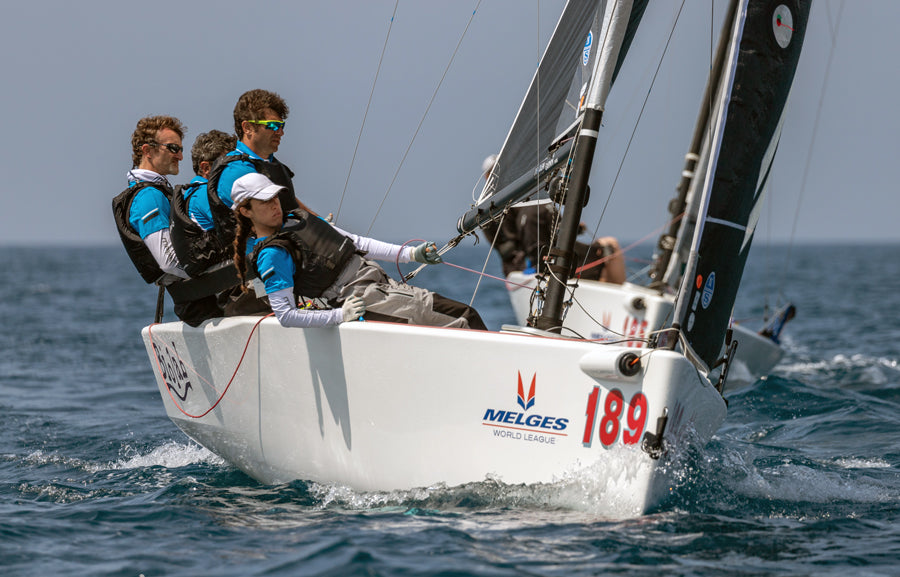
Melges 20 teams sail with three or four crew, total weight ranging from 550 to 620 pounds. Upwind, crew lean out against a strap along the rail and in light air, one will move forward of the shrouds.
New boats or used, what are the options?
Several hundred boats have been built in the short time the Melges 20 has been sailing, and the hulls last a long time. In North America, there are quite a few good boats for sale in the range of $22,000-$37,000. Besides the amount of wear and tear based on usage and care, price differences are often due to the quality of the electronics, with some boats having newer B&G equipment. Some older boats had a retrofit on the mast-step bulkhead to tab it in better, which is important. A lot of boats have a foam deck in the cockpit, as well, which will raise the price. A new boat with all covers and sails costs between $60,000 and $65,000.
Beyond the basics, what kind of prep is needed to make a Melges 20 competitive?
If you buy a used Melges 20, inspect the top swivel of the jib on headstay and plan to replace the ball bearings—they wear out quickly. Some teams buy a second swivel and replace it every regatta. That really helps with the furl in heavy air. You’ll also likely replace the ball bearings in the shroud cars.
How does a Melges 20 move around on land?
Boats typically come with “keel-up” trailers that have one or two dock boxes on the tongue. The boat itself weighs 1,146 lbs. (520 kgs.) so it doesn’t take a big vehicle to tow the boat. There are a couple of tricks for launching and retrieving, depending on whether you are using an electric hoist or a launch ramp. The
North Sails Tuning Guide
covers these in detail.
What's involved in rigging/derigging?
One person can step the mast, but it’s safer with two people. The mast hooks into a deck-step fitting, and you just push it up from the stern. At regattas, one crewmember can rig the boat in one to two hours.
What kind of inventory does North recommend?
The Melges 20 class has sail purchase limits. To make Melges 20 sails last longer North Sails shifted to 3Di, which has no Mylar in the laminate. It had previously been used only on boats above 30 feet, but after testing a number of different fiber combinations, 3Di sails won a third of the races at the 2017 Worlds.
North products for the Melges 20
continue to evolve.
The spinnakers take some abuse due to the takedown system, so most people replace them fast. The style of spinnakers has changed over the years. When the boat was first launched, everyone used a Runner as on the Melges 24. As we sailed the boats more we noticed that the 20 can plane sooner than the Melges 24, so the fleet started to sail more "bow up" in a lower wind range and the Reacher spinnaker became more popular. North offers both styles. Some teams carry two Reachers, but most carry one of each.
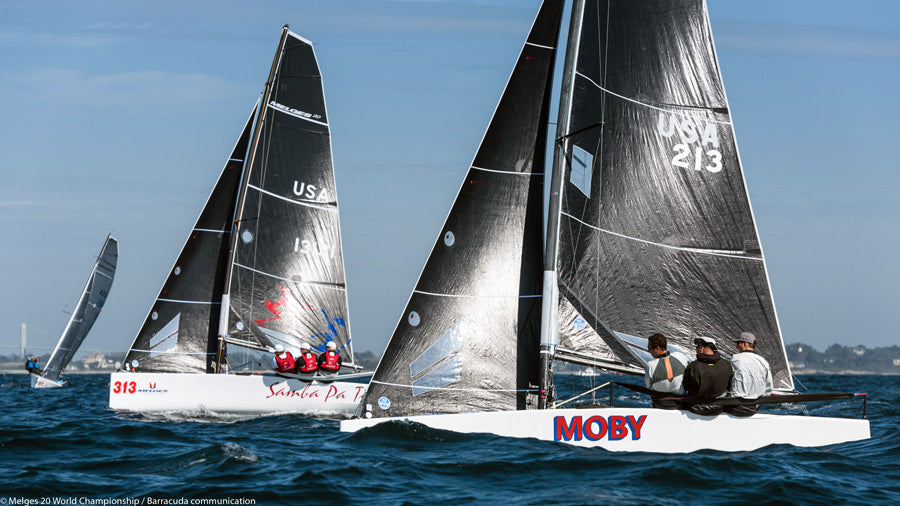
Sailing upwind in waves, the shrouds on these Melges 20s have been tightened to increase prebend and flatten the sails. The crews shift aft as needed to keep the bow up.
Melges 20 Tuning
What are the most important ways to tune this boat to good all-around base settings?
Setting mast rake is a fundamental starting point, measuring from the tip of the mast to the transom. But unlike many other one-designs, the boat not only has upper and lower shrouds, but also diamond shrouds, which help support the mast and change its mast-bend characteristics. You first set the tension of the diamonds before you raise the mast, and then once the mast is up, as you add upper shroud tension, your diamonds become softer and you need to firm them up. Eventually, you find a good balance point. You don’t need to do this every time you sail, only when stepping and tuning the mast in a new location. For detailed instructions, read the
North Sails Tuning Guide
.
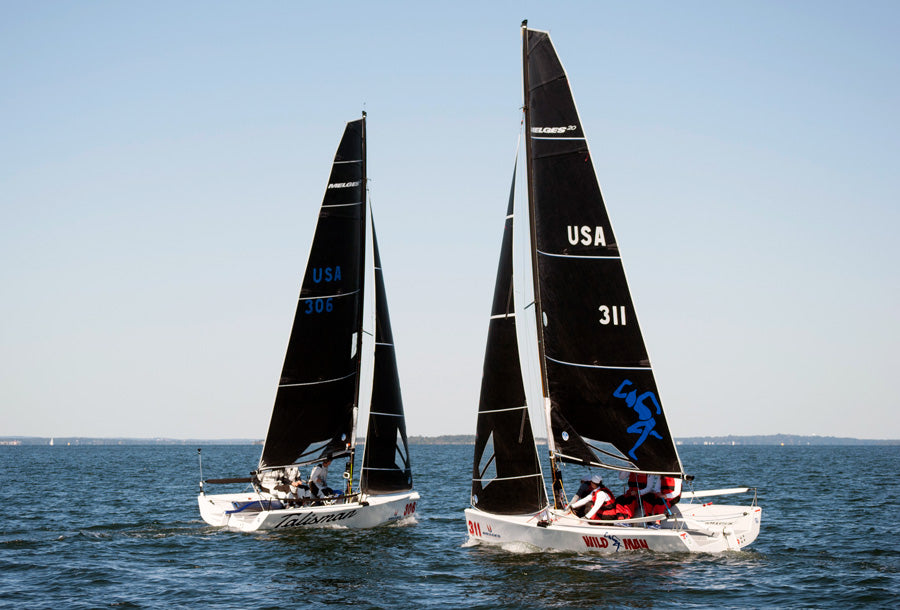
In light air upwind, the main leech is sheeted relatively tight and the crew sits far forward to keep the stern up.
Melges 20 Upwind Sailing
Upwind, where does the Melges 20 crew sit?
In all conditions, the crew sits right next to each other. In light air, the forward or bow person can be forward of the stanchion and the other two push as far forward as possible. In medium air (8 to 15 knots) and flat water, the forward person moves 10 to 12 inches aft of the stanchion, and all three crew sit shoulder to shoulder. If it gets any windier, move everyone one half to a full body width aft.
What are the key changes in different conditions?
The Melges 20 hull has a little chine aft, and in light air we like to get it out of the water to reduce drag. However, the bow is very fine, and it will start to dig in as the breeze comes up. Sometimes you’ll hit a wave and the bow will go right down, until the deck is nearly under. That’s a good indication it’s time to move crew weight aft.
What do you focus on when trimming main?
There’s no traveler, and most people set the bridle in “max up” position. In light air, trim will typically be not quite two-blocked—3 to 4 inches between blocks on the mainsheet bridle. We sail with almost no vang or cunningham. The head of the main is the most closed in light air, as we’re trying to generate power, but we watch that the top two telltales don’t completely stall out. We’re be constantly easing and trimming the main, and the leech telltales are stalled about 90 percent of the time. The jib is relatively small, so we’re always trying to generate power off the main.
In medium air (8 knots and up), we’re quick to go to the vang because that’s all that holds the boom down when we ease the main. As the breeze increases, keep squeezing on more vang—the mainsail has a square top, so it twists open easily and the telltales are always flying now. It’s fast to let the sail twist some, but not too much. We recommend putting a number strip or number marks on the vang track and learn what works best. Above 12 knots, we’ll be eased at least 4 to 8 inches on the mainsheet—and even more as the breeze builds.
Over 15 knots, we max out the vang and start tightening the cunningham. The cunningham not only pulls the draft in the mainsail forward; it also flattens the square-top and increases twist. First we take the wrinkles out of the luff, and then when the breeze builds to 18, even more cunningham is needed. A distinct vertical wrinkle appears along the luff, and the head really flattens out as the square-top section starts to ”float” a little bit. That’s a fast mode. The top battens are lightly inverting but not flogging.
https://www.youtube.com/watch?v=OwoEAZNC6ukWhat do you focus on when trimming the Melges 20 jib?
Under 8 knots of wind, we keep the jib’s top leech telltale streaming 100 percent of the time, which might mean a lot of ease. This helps keep flow going across the small keel and rudder.
At 8 knots, we begin to trim the jib tighter. The jib lead is all the way forward, and that’s when we start inhauling the weather sheet, gradually moving the clew to windward, up to 25mm. With a 2:1 sheet, we’re moving the windward sheet a total of 50mm. The jib is so small, there is not a lot of sail area to drive off; inhauling creates extra power aft in the sail.
At about 12 knots, we might need to move the jib lead back one hole to begin to depower, flattening the foot and creating a little leech twist to match the main. The jib is high aspect, so we don’t have to move the lead much to open the leech. As it gets windier, the trim stays similar, although we might trim the leeward sheet a bit tighter and inhaul less because we don’t need the power in the lower part of the sail. When the jib starts backwinding the main, that’s a good indication to ease. The Melges 20 sailplan is more like a skiff than any other kind of boat, with a similar trimming circle to a 49er or a 470.
Who is in the typical dialogue loop and what's a typical conversation?
A good helm will give feedback about how much pressure they feel on the tiller, especially in 8 to 15 knots, when fully powered. The bow is either “floating” or “not floating.” That feedback helps the rest of the team make adjustments to reduce or increase helm. A good question to ask the helm is, “Can you put the bow down when you need to?” If there’s too much pressure, it feels like the boat will tip over when the bow goes down; too little pressure means it’s hard to bring the bow up to point. Because the boat is so short, the helm can easily feel when the jib is not trimmed right.
Another important communication is when the main trimmer needs to ease and says, “We need to start going ‘Vang on.’” The forward person is usually looking forward and may need to be told to tighten the vang. They will also be ready to move the shrouds aft to tighten the headstay and depower the sailplan.
Melges 20 Downwind Sailing
Where does each person sit when sailing downwind?
In less than 8 knots, the jib will be furled and everybody in the crew will push forward. The spinnaker trimmer will be up next to the shrouds. The mainsheet/tactician will be sitting to leeward by the shrouds. The helm will sit as far forward as they are comfortable steering with the tiller extension. The goal is to get the chine near the transom out of water. This is VMG running, what we call “soak” mode. We don’t heel the boat to weather; in fact, a couple of degrees of leeward heel is usually fastest.
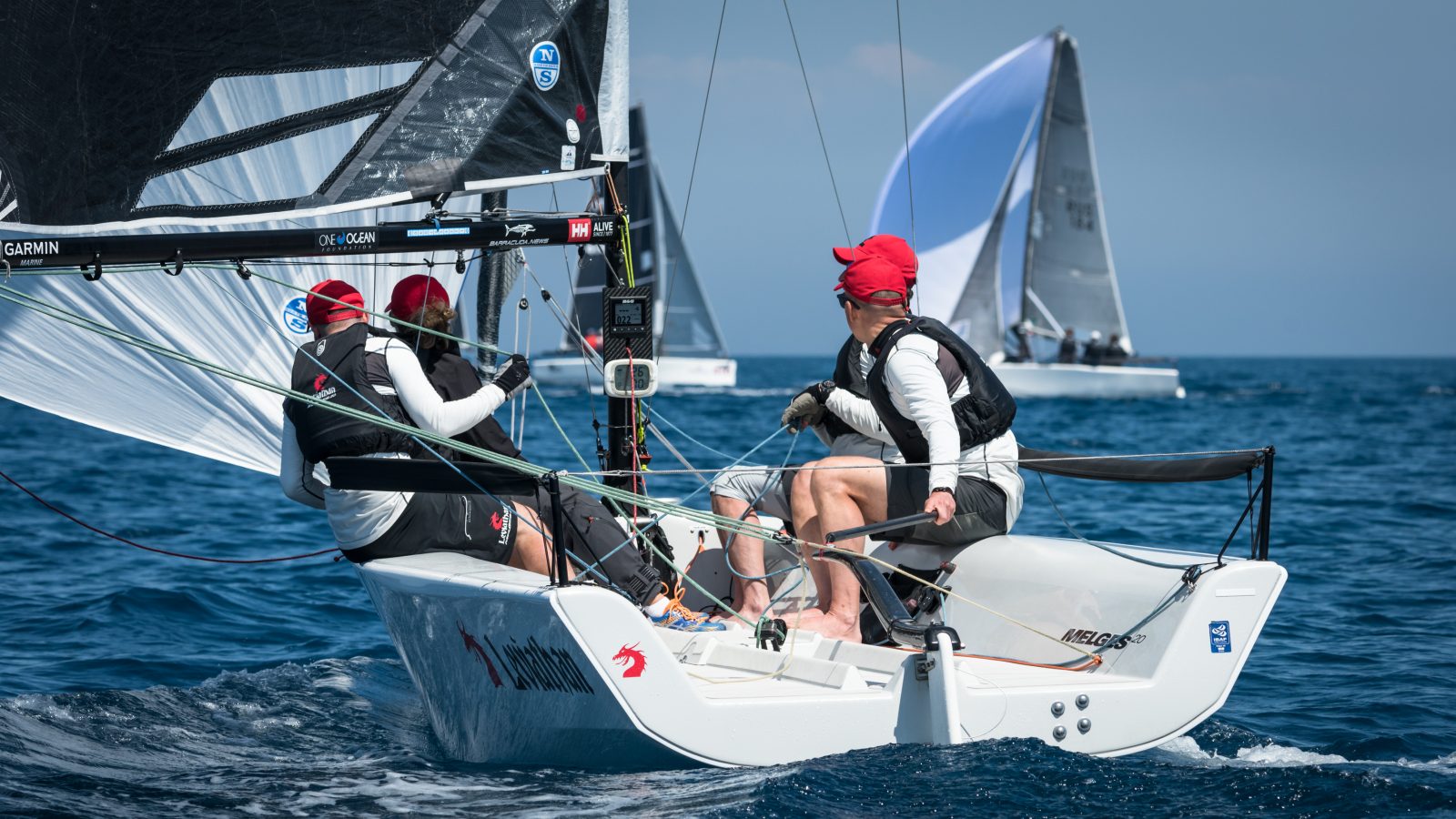
In light air, the spinnaker trimmer presses up to the shrouds with the helmsman as close by as is comfortable.
In medium air (8 to 15 knots), all three crew are typically to windward and still well forward. As the forward person trims the spinnaker, the tactician moves around the most to adjust the trim of the boat. At 12 to 13 knots, the boat is sometimes planing. To shift from “soak” mode for the puffs,, we move to weather and slide aft a little if the bow starts digging. This is “lazy planing” mode, and everyone is still relatively forward.
Oncewe’re in full planing mode, the tactician moves behind the driver, who also moves aft. The spinnaker trimmer then slides back just in front of the helm. The trimmer and helm are now leaning outboard as best they can. The tactician’s job is to just stay aft and not fall off the boat!
What do you focus on when trimming main and spinnaker in lighter air?
In lighter air and soak mode, ease out the main. Then simply pull it in when it starts to bubble. We typically sail in light to moderate air with no vang on. The spinnaker is eased and rotating to weather as we try to turn the bow downwind further. Most boats have speedos, and we’ll set a target, no faster than 7 knots. If we have more speed than that, we bear off more.
The target is never fixed; it’s always fleet dependent. In soak mode, it’s important to stay in a similar mode to the other boats. Once we are lazy planing, we start trimming the chute in as the apparent wind moves forward; we’ll have the jib unrolled and might need trim that, too, and then the main will need to come in a bit as well.

In “lazy planing” mode, the crew still sits in the middle of the boat and pumps spinnaker and main to promote surfing.
What is your sail trim focus on the Melges 20 when “lazy planing?”
In medium air, in puffy conditions, we often furl and unfurl the jib regularly, depending on the puff. Once the breeze hits 10 to 12 knots, the jib acts like a staysail and and gives extra speed, but in less wind it is slower. We furl the jib whenever we are sailing a steady course and the jib sheet goes limp. If it’s tensioned, it’s working. In general, we recommend keeping the jib trim slightly eased, on verge of luffing.
We are aggressive with spinnaker trim: there are no pumping rules for the spinnaker in the Melges 20, so if we’re in waves and the trimmer is strong enough, we can pump the chute and gain an advantage. The mainsail is restricted to one pump per wave; we keep it trimmed in a little bit, then let it back out when the apparent wind goes aft. Boats with strong, fit trimmers can be incredibly fast downwind in moderate conditions.
What is your sail-trim focus on the Melges 20 when fast planing?
When fast planing, there’s less spinnaker trimming. We keep the sheet eased as much as possible without collapsing the sail, which takes pressure off the bow and allows the helm to drive where they want. If the spinnaker is over-trimmed, it loads up the helm.
We think of mainsail trim almost like a trim tab when fast planing. We trim to heel the boat a couple degrees, keeping the boat loaded on its leeward chine. A consistent angle of heel reduces rig movement and maintains smoother airflow. Imagine that there’s a box drawn around the masthead; at a perfect angle of heel, the mast stays right in the center of the box.
In this condition, the mainsail leech will be pretty twisty, with the vang eased. The main boom will be over the leeward corner of the boat, which helps provide a little leech tension and a bit of tip support for the mast.
What are the key changes in different conditions?
On a big wave, in marginal planing conditions, we stay in a bow-up mode if we’re in any doubt. Some Melges 20 sailors have a tendency to bear off too soon, hit the next wave, and slow down. If the waves are right for a lazy plane, but not big enough to surf consistently, it’s better to sail bow-up at a consistent speed, even if we sail a bit more distance.
Who is in the typical dialogue loop downwind and what's a typical conversation?
In lighter conditions, most of the dialogue is between spinnaker trimmer and helm, with the trimmer talking about the load on the sheet. On our boat, the tactician will chime in with information on the boat’s speed or angle compared to the fleet, which helps the trimmer know if we’re at a good target boatspeed.
We have the same dialogue on sheet load when in planing mode. Often, the trimmer is coaching the helm to sail up or down. In this condition, it’s also important for the tactician to call the puffs. In 15 knots and more, the boat will want to nosedive at times and there’s a fine line between when to come up and when to keep driving down; easing the spinnaker and heading up keeps the bow from diving. The masthead spinnaker is as big as a Melges 24 chute, and sometimes the trimmer will have to ease and halfway collapse the chute to take pressure off the bow—then quickly trim back in. This is also a good idea because it reduces the risk of breaking the mast.
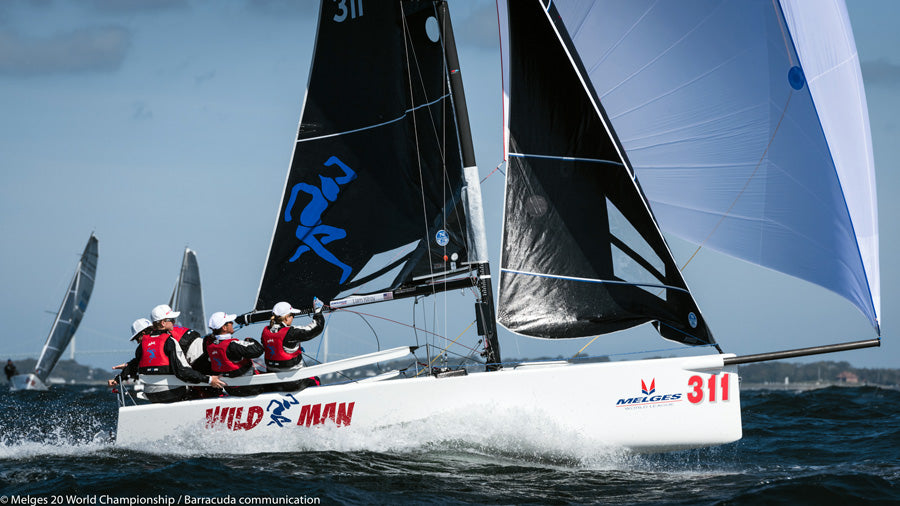
With the breeze up, whether sailing with three or four crew, weight must be moved aft to promote planing. With the apparent wind forward, the main is trimmed close to the aft quarter, supporting the top of the mast.
Melges 20 Boathandling
What's a typical start like in the Melges 20 class?
At the start, if the wind is above 8 knots, jibs remain furled until the last 20 seconds. The main is big enough to set up on the line and slowly creep forward. The boat accelerates really quickly and can be at full speed in 10 to 15 seconds. Below 8 knots, the jibs come out sooner.
What are three top tips for starting the boat well?
Create a good hole to leeward. The blades are high aspect and the boat will slide sideways when the jib is unfurled.
Communicate! The tactician often calls trim and coaches the helm through the start. The jib trimmer watches for “snipers” coming in to leeward.
Practice downspeed maneuvering and holding a spot.
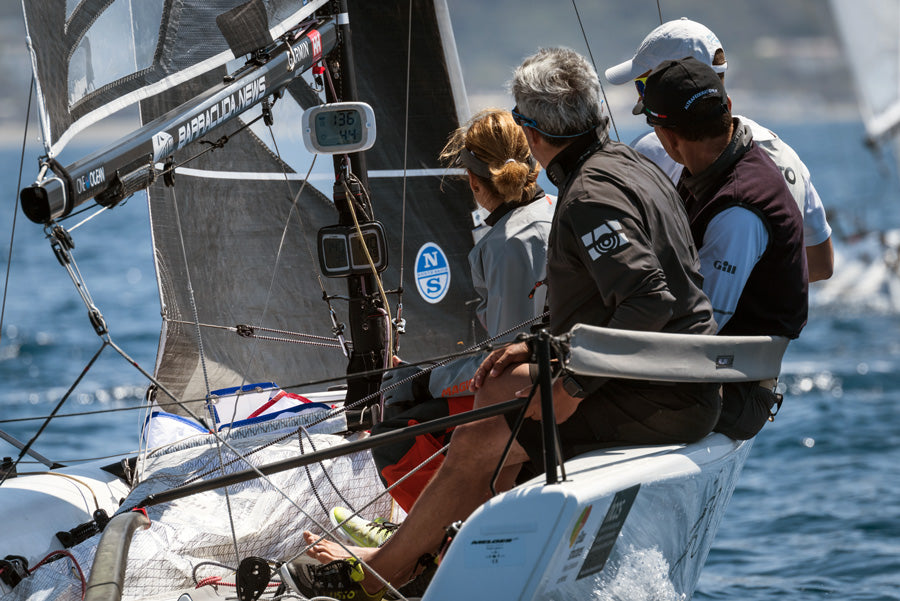
Some of the unique features of the Melges 20 include inhauling or weather sheeting the jib, a spinnaker storage bag on the port side of the cockpit floor, and a compass/speedo on the mast that's useful for tracking when a boat is slowing too much in the prestart.
What tips can you offer for downspeed boathandling?
Get used to the boat’s acceleration in a given wind speed, and set a bottom target speed for the forward person to watch—usually 2 to 2.5 knots on our boat. Below that, when we trim in, we drastically slide sideways before going forward.
What mistake slows down the Melges 20 most in a tack?
Don’t over-steer. The boat pivots quickly, and it’s easy when starting out to come out too deep and too heeled over; that makes the boatgo sideways. It’s better (although not by much) to have a slightly thin tack and come out going a little too slowly.
What does each crewmember do in a tack?
In light air, the crew will do a slight roll tack, delaying the move across the boat, but as soon as you have 8 knots of wind, all will switch sides immediately. The boat has plenty of power. Other than that, the helm steers through tack, and the middle person eases and trims the mainsheet. The forward person handles both jib sheets, backwinding the jib in light air for only a moment. The trimmer will cross the boat and lean out on the lifeline, trimming the jibsheet on the way across the boat.
We mark the jib sheet between the lead and the ratchet block. Coming out of the tack, we leave the sail eased one inch but then quickly go to max trim and squeeze on the weather sheet (inhauler). The boats tack so fast they may only lose half a knot of boatspeed.
What are the keys to a good Melges 20 tack?
In light air, don’t let the boat heel over too much coming out of the tack—the main trimmer should ease the sheet quite a bit to prevent that. In heavy air, it’s as simple as getting to the other side quickly and hiking.
What are the keys to a good jibe in lighter air?
When sailing in “soak” mode, start to rotate the spinnaker before the main comes across. The helm will slow the turn slightly when dead downwind, so the clew should come around the headstay before the boom jibes across the boat. The middle person’s primary job is to pull the mainsail across and roll the boat. The forward person handles both sheets and rotates the kite.
What are the keys to a good jibe when it’s windier?
When full planing, the goal is to do what is called a “blow-through jibe,” but first things first: the tactician is behind the helm and the forward person is just forward of the helm. Usually the tactician jibes the main from the back purchase of the mainsheet, and the key move is to get the purchase over the helmsman’s head.
The trimmer has a lot going on. Both the jib and spinnaker are flying, so the first thing to do is to take the slack out of the windward spinnaker sheet and cleat it. Next, reach to leeward and trim on the jib sheet on that side. As the jibe starts, the trimmer will pull in an arm-length of spinnaker sheet, which provides both leech and foot tension. The helm turns the boat quite quickly compared to a soaking jibe. This causes the spinnaker to invert and get plastered against the rig, which acts like a ramp for the spinnaker to slide around the headstay. The trimmer then grabs the lazy (windward) spinnaker sheet, drops the active sheet, and trims the new one as fast as possible. The spinnaker comes around and fills right away.
The advantage of the blow-through jibe is that you don’t have to over-trim the kite to get it to fill on the new side and risk rounding up in the process; it’s already eased and full and the helm has a lot of control. If executed well, you stay on a plane through the jibe, which gives the tactician options. This takes a lot of practice—when our team learned it, we spent a whole day doing nothing else. It’s quite different for the helmsman and trimmer. For the trimmer, the mechanics take some time to get right, and for the helm, it takes getting used to a fairly quick, deliberate turn from one downwind angle to the opposite angle. Come out too high and you’ll wipe out; too low and the kite doesn’t blow through to new jibe.
What is your No. 1 tip for jibing practice on the Melges 20?
Use an old spinnaker.
What is the key to a fast spinnaker set?
The Melges 20 is low to the water. We put a mark on the spinnaker sheet and cleat it before the set. The forward person hoists the spinnaker, and the tactician must wait for half the kite to be hoisted before the pole goes out. Otherwise the kite wants to dump straight into the water. The sail lives in a spinnaker sock on the port side of the mast, and the pole and tack line are one line. Before arriving at the mark, we discuss whether the jib will be furled or not on this downwind leg. Except in super light air, there’s no rush to furl it.
What is the key to a clean spinnaker takedown?
Because the Melges 20 has a takedown line, douses are relatively easy. The tactician moves to the middle of the boat where the takedown line is located. We recommend pre-loading that and counting down “3, 2, 1” to when the halyard is popped and spin sheet released. Count off two or three more seconds and then release the line for the tack and pole. Waiting the extra couple seconds allow the tactician to pull the whole sail in. If in soak mode, unfurl the jib first. If the jib is already unfurled, trim it in a little so it doesn’t get caught in takedown line.
Windward takedowns are easier and cleaner than leeward takedowns, because the line through the takedown patches turns the spinnaker into a flag. It comes right around the headstay and into the boat. On a leeward takedown, if you forget to remove all of the slack from the takedown line, you risk dropping the sail in the water.
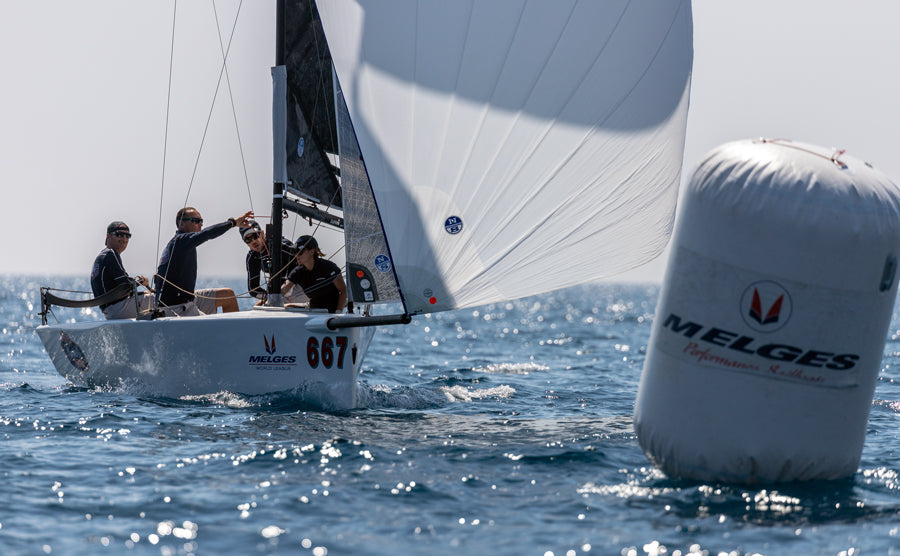

Keeping weight well forward in lighter air, a crew approaches the leeward mark, retrieves the spinnaker, and retracts the pole before turning upwind.
How easily does the Melges 20 broach or capsize?
Pretty easily. Downwind it’s easy to wipe out on the blow-through jibe if you come out too hot. If that happens, the boat usually comes back up quickly—backwind the jib and the bow comes back down to course. Sometimes you’ll need to drop the spinnaker to re-right the boat.
What are the most common boathandling mistakes made in this class?
During the set, if you send the pole and tack out too quickly, the spinnaker will go in the water.
What is the coolest thing about the Melges 20 class?
That’s easy to answer. It’s such a fun boat to sail, which is why people are so happy when they come into the dock. As soon as you have 10 knots of wind, you’re close to planing.


